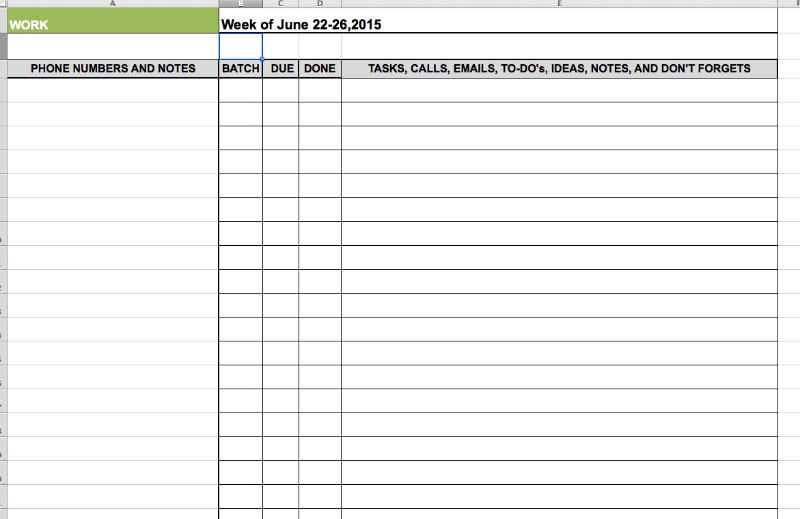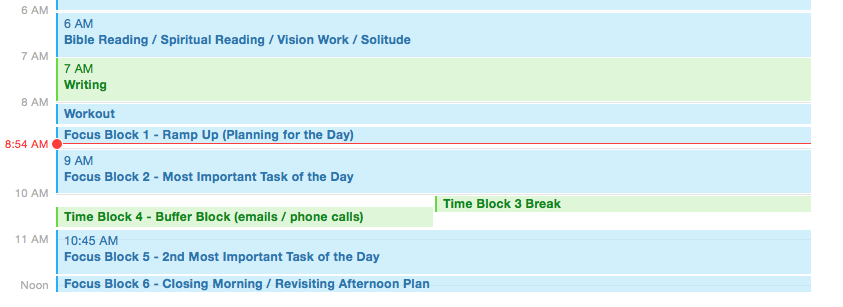Why the Strategy of Time Blocks Will Dramatically Change Your Productivity
Rick’s average work day is, well, simply out of control. He feels like he’s never able to get anything done between the relentless emails, urgent phone calls, and painful meetings.
Yet the irony of Rick’s day is most of it is within his control. Huh.
IF he wanted to make some changes, he actually could. And today.
Of course, there are certain meetings that he doesn’t organize but for the most part, the day is his canvas which right now he lets everyone else throw their paint on whenever and however they want.
Does any of Rick’s day resonate with you?
If there is one complaint I hear almost more than anything else it would have to be in the structure of one’s day.
The good news is this is a solvable problem frustrated productivity fans.
The Answer: TIME BLOCKS
What is a Time Block? Pre-decided periods of time to focus on a particular activity without interruption
The strategy is simple but the discipline is difficult only at first.
I found that once I learned how to use Time Blocks in a way that worked for me, I was hooked and the results stood for themselves. In fact the majority of my day uses this strategy.
Time Blocks are not intended to be restrictive or limiting. In fact, just the opposite.
They’re meant to bring freedom and control by limiting stress and distraction and increasing productivity and time mastery.
I also found I limit my procrastination of the things I don’t want or like to do (read this) by implementing Time Blocks. Interested?
(I have a personal example at the end if seeing a Visual of the Suspect sooner than later…)
How do you even begin? You need to do some intel first:
Determine the Elements of Your Average Week
Most of us have certain elements that are part of our average day / week. What are they? Make a list.
You’ll need this intel to begin determining the blocks of time for your day and week.
For me, I have conference calls, CRM, emails, meetings, expense reports, etc. (and those are just the fun things!) then writing, planning, Think Space (which everyone must try).
Determine the Frequency / Length
Are they once a week? Once a day? Multiple times a day?
Some tasks and meetings are obvious. Others reveal their timing once you start to schedule a specific time in for them each day and week.
The point is you need to have a rough idea of how long to plan for each element’s Time Block.
Determine Similar Tasks to Batch
Do you see a common theme? There are a few items that could easily be batched together for efficiency.
The more you can cluster like items, the more productive you can become because you can focus your efforts on one specific type of task.
For example, I will batched my emails together so I can get in a rhythm. Another batch would be emails or organizing / filing.
Determine If / How Often for Buffer Blocks
A Buffer Block is a set time to bulk similar tasks together.
This means if you did them together, you could get more done because you’re focusing on the same types of activities.
Some people choose to answer email twice a day. Your job may require more. You need to determine what is best for you. It took me awhile to settle on an average of 3-4 on any given day.
Once I’ve gathered the above intel, now it’s time to begin scheduling. But how?
Schedule Priorities
The reality is certain tasks / activities have a higher priority and must be scheduled first at the beginning of your day.
There are certain priorities that often get pushed to the end of the day and get the leftover time. Not ideal and rarely effective.
Not with Time Blocks. They get scheduled in and at the time / length best for you.
Schedule Energy
You know when you’re the best so maximize that energy.
For example, my creativity is the highest in the morning and the best time for me to write, plan, etc.
My willpower is also the highest so if there’s a task or project that I don’t like to do, then I try to start it mid to late morning when my patience is higher and I can give it some quality time.
Yet my afternoon is more task-oriented after a creative or thinking-oriented morning. Know thyself.
Schedule Similarities
I used to be random with my emails and phone calls. These two necessary evils would throw me off of my focus more than anything within my day.
I would find myself stopping what I was doing to return an email instantly only to get a response back two days later. And my reward? Losing the momentum I had with whatever I was working on in the moment. If I could remember.
Now I have 3 or 4 buffer blocks to focus on just emails or phone call. I cannot even begin to tell you how many emails I can knock out when I’m in that specific time block zone.
But when the time is up, your email is closed.
Using a Master List is key to the success of Buffer Blocks because the Master List has all of your tasks for the week in one place. So, when I need to cluster my emails or phone calls, they’re all in one place. To read more about the Master List, click here. Below is the list…
I suggest implementing the Master List with Time Blocks.
Note: if getting ahold of you is important enough, they’ll find you another way (text, iMessage, Lync, Skype, etc). The goal is to limit distractions during a particular time block.
Schedule Variety
I’m a person of variety. I love Time Blocks but I also need to make sure I’m not on the same task endlessly. My attention wanders and so does the quality of my work.
So variety is my answer. I know I am best scheduling creative in the a.m. and task in the p.m.
But you may be completely different. Again, know thyself but try to keep yourself fresh by adding some variety to your day when at all possible.
Personal Time Block Example
I’m a visual person and often seeing an example helps me get the concept so here’s a screenshot of my average morning with using the Time Block Strategy:
Closing Challenge…
Do Time Blocks work all the time and just like you planned it? Of course not. But the amount of productivity dramatically increases because you’ve scheduled your priorities, energy, similarities, and schedule. Do your intel.
And one of the quickest ways to productivity is choosing not to make excuses of what you don’t have control of within your day and start taking responsibility for the areas you do.
I’ve found this one area separates the busy from the productive.
The Time Block strategy could be a game changer for you and one I suggest to everyone who wants to increase their productivity and ultimately their results.
Closing Question…
What are your possible Time Blocks and how can you implement this productivity strategy today?
`




[…] should implement the strategy of Time Blocks. You need to be strategic in choosing when you can lock in dedicated time to move your Biggest Win […]